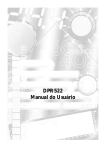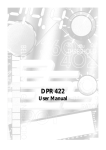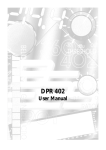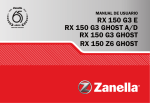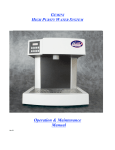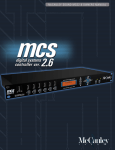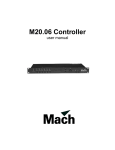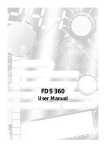Download BSS Audio DPR 522 User manual
Transcript
DPR 522 User Manual 1 V 1.0 JMK 11 June 1997 This equipment has been tested and found to comply with the following European and international Standards for Electromagnetic Compatibility and Electrical Safety: Radiated Emissions (EU): RF Immunity (EU): Mains Disturbance (EU): Electrical Safety (EU): Radiated Emissions (USA): Electrical Safety (USA): Electrical Safety (CAN): EN55013 (1990) Associated Equipment EN50082/1 (1992) RF Immunity, Fast Transients ESD EN61000/3/2 (1995) EN60065 (1993) FCC part 15 Class B UL813/ETL (1996) Commercial Audio Equipment UL813/ETLc (1996) Commercial Audio Equipment IMPORTANT SAFETY INFORMATION DO NOT REMOVE COVERS. NO USER SERVICEABLE PARTS INSIDE, REFER SERVICING TO QUALIFIED SERVICE PERSONNEL. THIS EQUIPMENT MUST BE EARTHED. IT SHOULD NOT BE NECESSARY TO REMOVE ANY PROTECTIVE EARTH OR SIGNAL CABLE SHIELD CONNECTIONS TO PREVENT GROUND LOOPS. ANY SUCH DISCONNECTIONS ARE OUTSIDE THE RECOMMENDED PRACTISE OF BSS AUDIO AND WILL RENDER ANY EMC OR SAFETY CERTIFICATION VOID. For continued compliance with international EMC legislation ensure that all input and output cables are wired with the cable screen connected to Pin 1 of the XLR connectors and/or the jack plug sleeve. The input XLR Pin 1 and the side-chain input jack socket sleeve are connected to the chassis via a low value capacitor, providing high immunity from ground loops whilst ensuring good EMC performance. Please read We have written this manual with the aim of helping installers, sound engineers and musicians alike to get the most out of the DPR-522. We recommend that you read this manual, particularly the section on installation, before attempting to operate the unit. The manual is split into two main sections. The first deals with quick reference information, regarding the functions and operation of the unit, while the second covers a more general background to use and application of the DPR-522. We welcome any comments or questions regarding the DPR-522 or other BSS products, and you may contact us at the address or World Wide Web site given in the warranty section. 2 Contents Contents 1.0 Mechanical installation 5 2.0 Mains Power Connection Mains Power 6 6 3.0 Introduction 7 4.0 Unpacking 7 5.0 5.1 5.2 5.3 5.4 Audio Connections Main Inputs Main Outputs Key returns Key send 10 10 10 11 12 6.1 6.2 6.3 6.4 6.5 6.6 6.7 6.8 6.9 6.10 6.11 6.12 6.13 6.14 6.15 6.16 6.17 6.18 6.19 Control Operations Channel In Key filter Width Key listen Ext key Threshold Key level meter Range Attack ADE Hold Release Open check Duck mode Stereo link Gate open indicator Key send connector Key return connector Control connector 13 13 13 13 14 14 14 15 15 16 16 17 17 17 18 18 19 20 20 20 2.1 6.0 3 Contents 7.0 7.1 7.2 Beginners guide What are gates for? Basic operation 22 22 23 8.1 8.2 8.3 8.4 General applications Basic gating Frequency conscious gating Ducking Using the Key filter as EQ 24 24 24 25 25 Warranty Information 26 10.0 Specifications 27 11.0 Glossary 28 Index 30 User Notes 32 8.0 9.0 4 Mechanical Installation 1.0 Mechanical installation A vertical rack space of 1U (1¾" / 44.5 mm high) is required, with a depth of 190mm. Ventilation gaps are unnecessary (See Figure 1.1). If the unit is likely to undergo extreme vibration through extensive road trucking and touring, it is advisable to support the unit at the rear and/or sides to lessen the stress on the front mounting flange. The necessary support can generally be bought ready-built as a rack tray, or the DPR-522 can be mounted between other units. Damage caused by insufficient support is not covered in the warranty. To prevent damage to the paintwork on the front panel, always use protective plastic cups or washers underneath the rack mounting bolts. As with any low-level signal processing electronics, it is best to avoid mounting the unit next to a strong source of magnetic radiation or heat, such as a high power amplifier. Fig 1.1 Unit dimensions. Fig 1.2 Rack dimensions. 5 Mains Power Connection 2.0 Mains Power Connection 2.1 Mains Power WARNING! THIS APPLIANCE MUST BE EARTHED. The DPR-522 must always be connected to a 3-wire earthed AC outlet. The rack framework must also be connected to the same grounding circuit. The unit must NOT be operated unless the power cables' EARTH (ground) wire is properly terminated - this is important for personal safety as well as for proper control over the system grounding. The wires in the mains lead are colour coded in accordance with the following code. Green and Yellow......Earth Blue......Neutral Brown......Live Those units supplied to the North American market will have an integral moulded 3 pin connector which is provided to satisfy required local standards. IMPORTANT: The DPR-522 is designed to use 50/60Hz AC power in one of the two voltage ranges, selectable with the mains voltage selector switch on the rear of the unit. It is vital that the position of this switch is checked BEFORE initial power up to ensure that it matches the local mains supply. Acceptable input AC supply voltages range from: 115V switch position 230V switch position - 90V to 132V 190V to 265V The application of voltages outside these ranges may cause permanent damage or erratic operation of the unit, and will invalidate the warranty. IMPORTANT: The mains fuse carrier on the rear of the unit must be fitted with the correct type and rating of fuse, depending on the position of the mains voltage selector switch: 115V switch position 230V switch position - T315mA fuse T200mA fuse In the unlikely event of the mains fuse failing without good reason, DISCONNECT THE UNIT FROM THE MAINS SUPPLY, and always replace with the appropriately rated fuse (as specified above) for continued protection against damage and fire. Note: For USA and Canadian users, the replacement fuse must be of an identical UL rated type fuse for continued compliance with safety standards. 6 Introduction Unpacking 3.0 Introduction The BSS DPR-522 is a dual channel high performance professional noise gate which has been designed to be simple and intuitive to use. Many of the facilities provided on the unique BSS DPR-502 unit, such as the parametric key filters and key signal metering have been incorporated, with some new features added. One unique feature of BSS gates, featured in the DPR-522, is the adoption of true logarithmic audio level control during both the attack AND release phases. This ensures the most natural sounding fades, which are very important if long attack or release times are used. The provision of balanced key send and return signals minimises the possibility of interference, which other units with unbalanced connections may suffer from, whilst having separate send and return connectors eases the integration of other equipment with the DPR-522. To further enhance the unit's flexibility, extensive control of the DPR-522 is possible using external DC control signals and switches; inputs are available to remotely trigger the gate or inhibit it. Both contact closure and logic signals may be used for this. In addition a signal is provided by the DPR-522 when the gate opens, which may be used to trigger other external equipment. 4.0 Unpacking As part of the BSS system of quality control, we check every product carefully before packing to ensure that it reaches you in flawless condition. Before you go any further, please check the unit for any physical damage and retain the shipping carton and all relevant packing materials for use, should the unit need returning. In the event that damage has occurred, please notify your dealer immediately, so that a written claim to cover the damages can be initiated. Check out section 9.0; warranty section, for more info on the warranty, and also to record your dealer details. 7 The DPR-522 Fig 4.1 Front Panel Fig 4.2 Rear Panel 8 All numbers in bubbles refer to Section numbers. 9 Audio Connections 5.0 Audio Connections 5.1 Main Inputs There are 2 input sockets on the rear panel of the 522, Inputs 1 and 2. Each is electronically balanced on standard 3 pin female XLRs at an impedance greater than 10k Ohms. The ‘HOT, + or in phase’ connection is to pin 2 and the ‘COLD, -, or out of phase’ connection is to pin 3. Pin 1 is internally connected to the chassis earth via a low value capacitor. This ensures freedom from ground loops whilst allowing good EMC performance. The screen of the input cable should be connected to pin 1 to ensure that EMC regulations are being met, and the cable shield ground should also be connected to the equipment which is providing the input signal. Fig 5.1 522 When feeding the DPR-522 from unbalanced sources, connect the signal conductor to pin 2 and the cable screen to pins 1 and 3. Transformer isolated inputs are available as a dealer fitted option. Fig 5.2 5.2 Main Outputs 522 The output signals are electronically balanced and fully floating on 3 pin male XLRs. Full headroom is available into any load of 600 Ohms or greater. The signal ‘HOT, +, or in phase’ signal is to pin 2, the ‘COLD, -, or out of phase’ signal is to pin 3, with pin 1 being connected directly to the chassis. Fig 5.3 522 10 When using the DPR-522 to drive unbalanced inputs, best performance is usually obtained by connecting the DPR-522s ‘+’ signal to the equipment signal pin and the ‘-’ signal to the equipment shield. Fig 5.4 522 The DPR-522 shield should normally be connected to the equipment shield, preferably at the equipment end. Transformer isolated outputs are also available as a dealer fitted option. 5.3 Key returns The side chain insert inputs are electronically balanced via stereo 5mm jack sockets at an impedance greater than 100k Ohms. The ‘HOT, +, or in phase’ connection is to the jack plug tip, the ‘COLD, - or out of phase’ connection to the ring. The shield is internally connected to the chassis earth via a low value capacitor. This ensures freedom from ground loops whilst allowing good EMC performance. The screen of the cable must be connected to the jack plug shield to ensure continued compliance with EMC regulations. The cable shield ground should be connected to the equipment which is providing the input signal. Fig 5.5 522 Jack Input When feeding the DPR-522 from unbalanced sources, connect the signal conductor to the jack plug tip and the cable screen to the plug ring and shield. Fig 5.6 522 Jack Input 11 Audio Connections 5.4 Key send The side chain uses a quasi-balanced ‘ground compensated’ output. When connected to a balanced input, interference rejection equivalent to a fully floating output can be obtained. Full headroom is available into any load of 2k Ohms or greater. The signal ‘HOT, +, or in phase’ signal is to the jack plug tip. The ‘COLD, -, or out of phase’ signal is to the ring with the shield being connected directly to the chassis. Fig 5.7 522 Jack Output Connection to unbalanced inputs may be done by connecting the tip to the signal input and the ring to the input shield. The DPR-522 shield may or may not be connected to the equipment shield at the equipment end. Fig 5.8 522 Jack Output 12 Control operations 6.0 Control Operations 6.1 Channel In When the CHANNEL IN switch is in the out, non illuminated position, all DPR-522 functions are bypassed and the input is connected directly to the output with a high quality relay. This is the same condition that occurs when the power is off, and ensures that signal is passed through the unit in the case of a power or fuse failure. When the switch is pushed, the processed signal is present on the output. In bypass mode, the input is still connected to all of the DPR-522 circuitry, so that all of the required facilities can be selected and set up prior to operating the CHANNEL switch and going ‘on-air’. 6.2 Key filter This control adjusts the centre frequency of the internal key parametric filter. This filter is used to control the frequency content of the signal being sent to the gate control circuitry to allow the filtering out of signals not required to control the gating action. The filter is not placed in the main signal path, and therefore has no effect whatsoever on the program material passing through the gate. 6.3 Width This control adjusts the width of the internal key filter. This filter should be considered as a pair of tracking high pass and low pass filters, with the space between them controlled by the WIDTH control. It is thus possible to achieve a variety of key filter responses, from a very broad filter encompassing the entire audio band to a very narrow one for a very selective response. Normally it is best to start off with a fairly wide setting and then narrow down on the signal of interest, readjusting the KEY FILTER control if required. 13 Control operations This type of filter not only allows band-pass configurations, but also, by the appropriate setting of the KEY FILTER and WIDTH controls, the conventional low pass or high pass configurations can be easily realised. Experience will show that this approach gives considerable operational advantages for the user over the more simple separate low/high pass filter approach. 6.4 Key listen When this switch is depressed, it connects the output of the key filter to the output connector instead of the normal signal. This makes it very easy to adjust the KEY FILTER and WIDTH controls to ‘home in’ on the signal that is required to open the gate. To enable both hands to be used for adjusting the key filter, this switch is latching, and may therefore be left engaged by accident rendering the gate function inoperable - the switch illuminates red to warn you of this. 6.5 Ext key Normally with this switch out (un-illuminated), the input to the key filter is taken from the main input, allowing the main signal to gate itself. If it is desired to use other audio signals as a trigger, these may be applied to the rear panel KEY RETURN socket with the EXT KEY switch depressed. This signal can be heard by depressing KEY LISTEN, and both the filter controls and gate control will now work on this signal. 6.6 Threshold The filtered key signal is passed to the THRESHOLD control. The numbers around the THRESHOLD control indicate the approximate level in dBu that will be required from the key filter in order to just cause the gate to open. 14 With the control fully clockwise in the ‘out’ position, the gate will be held closed at all times. As the control is rotated anticlockwise, the threshold point is progressively reduced, or becomes more sensitive. You will find that as you set the WIDTH control narrower, it is generally required to reduce the threshold level to compensate for the smaller amount of energy being passed from the filter. In normal use the threshold control is generally set so that wanted signal peaks are just able to trigger the gate, this gives the maximum protection from false triggering by undesired signals. 6.7 Key level meter The relationship between the actual trigger signal (as set by the threshold control) to the gate trigger point is displayed on the KEY LEVEL METER. This meter displays the level of the key signal in dB relative to the level required to ‘open’ the gate. This level is the larger segment marked ‘TH’ on the meter. Notice that even with no key signal present the TH segment glows dimly, to ensure that even in dark conditions, the trigger point is visible. The meter has a very fast response time coupled with a decay time optimised to allow you to see rapidly recurring signal peaks. 6.8 Range With the gate ‘open’, the program can pass through the DPR-522 unhindered. When ‘shut’, the level of the program passed is set with the RANGE control. This can be varied from the full input level in the ‘out’ position to more than 80dB reduction - effectively no signal at all. Intermediate settings of the range control are often used to avoid the signal sounding ‘dead’ when the gate is shut, or to enhance or make less audible the gate dynamics. This is done by limiting the open to closed gain ratio to the minimum required. Remember also that if a very fast attack time is desired, it will take the DPR522 longer to open from -80dB than from, for example, -20dB. 15 Control operations 6.9 Attack Once the key level exceeds the threshold, the gate will start to open. The time it takes to open is set with the ATTACK control. For conventional gating, fast attack settings are usually desired to ensure that the minimum wanted program is lost. However, unnecessarily fast attack times should be avoided as they can produce a ‘click’. This click is not generated by the DPR-522 but is an artifact produced by the action of quickly switching a signal. To prevent this, increase the attack time until a compromise is found. Very slow attack times are available for special effects or when triggering the DPR-522 from either an external key or a DC or switch control to produce smooth fades. Because the DPR-522 uses true logarithmic level control during the attack phase, these fades will sound very natural. The attack phase, once initiated, will continue until the gate is fully open, even if the signal momentarily falls below the threshold level. This is important as it allows for both a clean, 'chatter free' attack phase and ensures that, especially with short hold and release times, the gate does not try to follow individual cycles of the program. 6.10 ADE Auto Dynamic Envelope is a technique developed by BSS to help restore an effective leading edge transient to the front of a gated program signal. As stated above, it is often necessary to use a longer than ideal attack time, this can result in the loss of part of the original signals’ initial transient. ADE operates at the commencement of each attack timing period, and allows the gate to ‘overshoot’, or provide gain, in a controlled way. This is most effective on single bursts of repetitive program that are percussive in nature and is used to restore ‘punch’ into the program sound. In operation, and depending on the nature of the program, ADE can provide a substantial subjective improvement to the sound and help to eliminate the dead or gated signature that is often imparted to signals. 16 6.11 Hold After the attack time is completed, the DPR-522 keeps the gate fully open for a time determined by the HOLD control. Hold is required to avoid the DPR522 from starting another attack sequence if the key signal momentarily falls below the threshold level. The hold time is reset every time an above threshold event is detected and therefore if there is never a pause in the program longer than the hold time, the gate will never shut. Short hold times can be used to help minimise jitter (the gate repeatedly opening and shutting very quickly). Longer times would be used when gating for example a vocal, to avoid the gate closing between words. 6.12 Release This is the final phase of operation and is entered after the HOLD time has expired. At the end of the time set with the RELEASE control, the signal will be reduced by the amount set on the RANGE control. During release the signal is reduced logarithmically. This produces a very natural sounding fade, essential for long release times. 6.13 Open check Depressing this switch will force the DPR-522 to commence its attach phase. It will stay open until the switch is released. Once released the DPR-522 will commence its hold and release phases. Open check is especially useful for listening to the input signal if the DPR-522 is setup to be triggered by a signal other than the program. It can also be used during live performances as a means of forcing open gated microphone lines to test their integrity. 17 Control operations 6.14 Duck mode Normally the DPR-522 would be configured as a gate, that is to say that the signal will be ‘cut off’ unless triggered, whereupon the signal will be passed through. DUCK MODE forces the opposite to happen; i.e. when there is NO trigger event (signal above threshold or DC/switch trigger) the DPR-522 will pass signals. When triggered by any of the normal means, the DPR-522 will attenuate the program to a level set by the range control. This facility is most often used in broadcast or PA applications to allow an announcer to ‘talk over’ the normal program. In duck mode the operation of the attack and release controls could be considered reversed. The time taken for the DPR-522 to reduce the program after being triggered is set with the RELEASE control, the time to restore the program after the event is set with the ATTACK control. The HOLD control works in the normal way. 6.15 Stereo link With this switch depressed, both channels of the DPR-522 can be made to operate simultaneously. The key signals from both channels are added together and applied to the controls and key level meter of channel 1 for processing in the normal manner. The gain control stage for channel 2 is disconnected from the channel 2 controls and connected instead to the control from channel 1. Therefore if either channel provides a sufficiently large key signal, both channels will open together with the gate status being displayed on channel 1s LEDs. In STEREO LINK mode, all the controls on channel 2, including the meter and status LEDs EXCEPT KEY EXT, are disabled. Channel 2 KEY EXT still operates and will select either the channel 2 main signal or the channel 2 key return signal for summing to channel 1. If it is not required for the side-chain signal of channel 2 to be summed with channel one, or visa versa, then the respective KEY EXT switch should be depressed. This then disconnects that channel’s signal - provided nothing is externally connected to the rear panel KEY IN jack socket. The main program inputs and outputs are not connected in any way in stereo mode, only the gating functions are linked together. 18 6.16 Gate open indicator If the gate is not passing program, the SHUT LED is illuminated. If it is passing program, the OPEN LED is illuminated. These LEDs fade from one to another during the attack and release times, their relative intensity gives a visual indication of the dynamic response of the gating action. One thing to remember is that during the attack and release phases, as stated earlier, the DPR-522 uses a logarithmic control law to give a smooth fade to the sound. When this is applied to the LEDs, especially for long release times, it may appear as though nothing happens for a while. What is in reality happening is that the sound and LEDs are fading but the LEDs are initially fading too slowly to be obvious. 19 Control operations 6.17 Key send connector This is a ‘pseudo balanced’ output and carries a buffered version of the signal applied to the MAIN input. It may be used as such, or can be connected to the input of external equipment for further processing. Refer to section 5.1 for the wiring details of this connector. 6.18 Key return connector If the KEY EXT switch is depressed, this fully balanced socket is the input to the DPR-522’s key side chain. It may be used as the return input from equipment being driven from the DPR-522’s KEY SEND connector, of if desired may be driven from another unrelated signal. Refer to section 5.4 for the wiring details of this connector. 6.19 Control connector This is an 8 pin DIN socket that provides a means for externally controlling the DPR-522 using switched or logic signals. The pins are assigned as follows: 1 GATE OPEN open collector output 2 GROUND 3 DISABLE HIGH input 4 PULLUP to +15V 5 EXTERNAL TRIGGER input 6 DISABLE LOW input 7 DISABLE PULLUP to +15V 8 GROUND 20 Pin 1 GATE OPEN Output An open collector output that goes LOW when the DPR-522 is passing signals. If an external pullup is used, limit the current passed by this pin to below 50mA at a voltage no higher than 25V. If desired this pin can be connected to an internal pullup on pin 4 to provide a signal that swings positive to +15V when the DPR-522 is not passing signals. Pin 5 EXTERNAL TRIGGER Input (High to trigger) Taking this pin to within 0.5V of ground with either a switch or logic level will cause the DPR-522 to open. This pin should never be made higher than 25V. If it is desired to use a normally open switch to trigger the DPR-522, connect this switch between this pin and ground. The DPR-522 will still respond to internal triggers. If this is not required, rotate the THRESHOLD control fully clockwise to the OUT position. Pin 6 DISABLE LOW Input If it is desired to use a normally open switch to DISABLE the DPR-522, connect this switch between this pin and ground. Please note that this input cannot be used when the DISABLE HIGH input is in use. Pin 3 DISABLE HIGH Input (Switch closed to inhibit) A voltage between 1V and 25V on this pin will stop the DPR-522 from opening. If it is desired to use a normally open switch to ENABLE the DPR522, connect this pin to pin 7, and the switch between pin 3 and ground. Please note that this input cannot be used when the DISABLE LOW input is in use. 21 Beginners guide 7.0 Beginners guide 7.1 What are gates for? Put simply, a noise gate is a device that blocks or switches off a signal if that signal falls below a certain preset level. Originally noise gates were used for just that, gating or removing noise from recordings. For example traffic rumble in studios, or electronic noise from old tape loop echo chambers. Noise gates or gates function by taking the main input signal and splitting it into two paths. One path passes through an electronic switch to the output and is not modified in any other way. The other, called the KEY SIGNAL is processed to provide a ‘trigger’ for the switch. Once the main signal has exceeded the user selected THRESHOLD and provided the trigger, the gate will open. In modern gates the switch is replaced by a fader circuit, thereby allowing the gated signal to be faded up and down, often quite slowly. The fade up rate is defined by an ATTACK control, the fade down by a RELEASE control. This fading action can be important, as the ear is much more sensitive to abrupt changes in level than gradual ones. One major application for modern advanced gates is the separation of sounds so that they may be processed separately, for example in a multi-miked drum kit. In this case each drum would have a separate microphone, the intention being to have independent control of the level and tonal balance of each drum. Unfortunately, due to the close proximity of the microphones, there will be significant bleed of sound from one drum to another. Gates are used to prevent this. They are set up to only open when their particular drum is hit. Unfortunate it is sometimes not easy to set a gate up to only trigger on the desired signal, quite often the wanted and unwanted signals are close to each other in level. This is where key filters are useful. Key filters are setup to condition the key signal by filtering out signals that don't originate from the drum in question, thereby increasing the difference between adjacent drums and making the job of ensuring that only the correct drum triggers the gate easier. Another use for gates is in the reshaping of existing sounds. Quite often sampled sounds will be used in recording. Sometimes these sounds may have an inappropriate attack or release sound for their intended purpose. By triggering a gate on the sample, and with careful setting of the attack and release controls, a new envelope, that produced by the gate, will be imparted to the sampled sound. Additional features are often added to contemporary gates, for example, the ability to trigger the gate with a signal that is not the same as the one being gated, or using external switches or logic signals to open or inhibit the gate. By introducing the possibility of control via a computer or sequencer, these facilities add enormously to the versatility of the unit and take its application into areas far removed from the original intention of the designers of the first ‘noise gates’. 7.2 Basic operation 22 These instructions are primarily designed to help you get started using the DPR-522. The front panel is split down the middle into two identical sections or channels. The left hand section will be referred to as channel 1, and the right hand section as channel 2. There is no difference in operation between these two channels, and so all the discussions will equally apply to both. The exception to this is STEREO LINK mode (described in section 6.15). In operation, the DPR-522 can be considered as an automatic on-off switch that is placed into the program signal line, the actual operation of the switch being controlled by the loudness level of the signal. The simplest way to understand the basic operation is to connect one gate channel into a program source and operate the controls whilst listening to their effect. Having connected the input and output leads according to the instructions in section 5 continue as follows: 1 Make sure that all push-buttons are out, in the non-illuminated position. 2 Set the ‘KEY FILTER’ control to 1KHz, and the WIDTH control to 8 oct. 3 Set THRESHOLD control to out, the RANGE control to 80dB, and the ATTACK, HOLD, RELEASE controls about centrally on their scale. 4 With the unit still in bypass mode (Channel button out) adjust the external equipment to give an adequate volume level, and then operate the CHANNEL switch. The signal should then be cut-off, and there will be no meter display. 5 Now gradually rotate the THRESHOLD control anticlockwise, and observe that the KEY LEVEL meter starts to indicate the peaks of the program. As soon as the display exceeds the partially illuminated TH marker on the meter, the program signal will be passed through to the output as the gate has now ‘opened’ notice too that the green OPEN LED has come on. Spend a few minutes adjusting the threshold control and watching the display. 6 Now adjust the RANGE control whilst listening to the program. The scale calibration indicates the attenuation of the signal when the gate is closed. This means that, rather than being simply on or off, the gate can be set to be slightly attenuated, or somewhere in between. Turning the control fully clockwise makes the gate closed level equal to the gate open level, and so it will appear that the gate is open at all times. The normal setting for this control will depend very much on the specific application, however for general noise reduction on background microphone clutter, a range of 20-40 dB will be a good starting point. 7 The ATTACK, HOLD and RELEASE controls can be intuitively operated. The ATTACK is the time taken for the gate to open once the threshold has been reached. The HOLD is the time the gate will remain fully open once the program signal has fallen below threshold. The RELEASE is the time taken for the gate to fully close once the hold cycle has finished. Take some time to experiment with these controls to hear their effects on the envelope of the program signal. Whilst doing this also observe how the gate OPEN and SHUT LEDs fade between each other, precisely following the sound. You will notice that these follow the actual times set by the ATTACK, HOLD and RELEASE controls and is a true indication dynamically of the state of the gate, whereas the KEY LEVEL meter has dynamics set to give a good indication of program level. This covers the basic operation of the DPR-522. For a more detailed description of the controls, please refer to sections 6.1 thru 6.19. For information covering specific configurations, please see section 8.0. 23 General applications 8.0 General applications 8.1 Basic gating Rotate the THRESHOLD control to the OUT position, apply a signal to the MAIN input and observe that there is no output. Rotating the THRESHOLD control anticlockwise, you should see some indication on the KEY LEVEL meter. When this activity exceeds the TH mark on the meter you will hear the signal appear and should see the GATE LEDs change state. If the signal is only allowed to briefly exceed the TH level the sound will appear chopped up. Adjusting the ATTACK, HOLD and RELEASE controls will change the nature of the sound. You may find that certain settings of these controls never allow the gate to close. Set the THRESHOLD so that the gate no longer opens, and now adjust the RANGE control. Notice that even though the gate is shut, as confirmed by the GATE LEDs, you can adjust the sound level anywhere between fully off and fully on. This can be useful as having the gate close too far can impart an unnatural character to the sound. 8.2 Frequency conscious gating Set the KEY filter control to 1KHz and the WIDTH control to 8 oct. With a signal applied to the MAIN input and depressing the EXT KEY switch, you should now hear the program. Rotate the WIDTH control and notice that the range of the sound changes, becoming more limited as the control is rotated anticlockwise. Leave the WIDTH control in approximately the 9 o’clock position and now adjust the KEY FILTER control. As you turn it anticlockwise, the bass notes will become prominent. Turning the control clockwise will cause the treble to become more prominent. Select some music with a heavy beat and set the KEY FILTER and WIDTH controls so that the beat notes are the ones registering on the KEY LEVEL meter. When you are happy with the filter controls, release the KEY LISTEN switch. Now adjust the THRESHOLD control until the beats, as displayed on the meter, just exceed the TH mark, you should now hear the beats in the program. Experiment with the filter and the ATTACK, HOLD & release controls to extract other sounds in the program. 24 8.3 Ducking For this example, a DJ ‘talkover’ application will be described. Apply the program that you wish to ‘duck’ to the MAIN input. Apply the DJ program that you want to cause the ducking action to the KEY RETURN input. Remember that if you wish to use a microphone as this signal, it may need amplifying first. Adjust the THRESHOLD control until the KEY LEVEL meter is swinging above the TH point when the DJ speaks. Adjust the RANGE control to give the required degree of ducking. Now set the RELEASE control so that when the DJ speaks, the program is attenuated smoothly. Set the HOLD so that the DPR522 does not change state between words, and adjust the ATTACK control so that when there is no DJ input the main program fades up appropriately. 8.4 Using the Key filter as EQ This is an unusual application as it does not use the DPR-522 as a gate. Each channel of the DPR-522 contains a good quality wide ranging parametric filter. This filter can be accessed by depressing the KEY LISTEN button, which passes the output of the key filter to the output. If the EXT KEY switch is out, the signal filtered will be that applied to the MAIN input. If the DPR-522 is used in this way, none of the gating features for that channel will be available and no controls other than those for the filter will be operable. Note: Controls shown in dark grey should be initially be set to the positions in the diagram, and the text will guide you through the application procedure. Light grey controls with no markers can be set at any position, and do not affect the setup of a particular application. 25 Warranty Info 9.0 Warranty Information When sold to an end user by BSS Audio or a BSS Audio Authorised Reseller, this unit is warranted by the seller to the purchaser against defects in workmanship and the materials used in its manufacture for a period of one year from the date of sale. Faults arising from misuse, unauthorised modifications or accidents are not covered under this warranty. No other warranty is expressed or implied. If the unit is faulty it should be sent to the seller of the equipment, in its original packaging with shipping prepaid. The unit will be returned to you when the repair has been completed. If the unit was purchased in the European Union, you may, as an alternative, return the unit to any other BSS distributor in the European Union. You should include a statement listing the faults found. The unit’s serial number must be quoted in all correspondence relating to a claim. IMPORTANT We recommend that you record your purchase information here for future reference. Dealer Name: Dealer Address: Post/Zip Code: Dealer Phone No.: Dealer Contact Name: Invoice/Receipt No.: Date of Purchase: Unit Serial Number: In keeping with our policy of continued improvement, BSS Audio reserves the right to alter specifications without prior notice. The DPR-522 was designed and developed by BSS Audio, Hertfordshire, England. Phone (+44) (0)1707 660667. Fax (+44) (0)1707 660755. World Wide Web address: http://www.bss.co.uk 26 Specifications 10.0 Specifications General Input Impedance Input Headroom Input CMRR Max Output level Output Impedance Frequency Response Noise Dynamic Range Cross Talk Distortion 10k ohm balanced or unbalanced >+20dBu >-50dB (30Hz-20kHz) >+20dBu into 600 ohms or greater <50 Ohms unbalanced or unbalanced 10Hz-80kHz (+/-3dB) -96dBu (22Hz to 22kHz) >117dB >-85dB (20Hz to 20kHz) <0.005%THD (80kHz measurement BW) 20Hz-20kHz. Typically 0.002% at 1kHz, Unity Gain +10dBm output below threshold Gate Threshold range Attenuation range Attack time Hold time Release time Noise -50dB to +20dB continuously variable -80dB to 0dB µs to 1.5s continuously variable 20µ 5ms to 2s continuously variable 1ms to 5s continuously variable <-94dBu (Open) <-98dBu (Closed) 27 Glossary 11.0 Glossary Active ADE Active electronic circuits are those which are capable of voltage and power gain by using transistors and integrated circuits. A special BSS feature that can be used to impart a new leading edge transient on sounds to make them sound less 'gated' and more punchy. Amplitude Refers to the voltage level or intensity of a signal, and is usually measured in voltage or decibels. Attack Time The amount of time taken for the compressor or limiter to kick in and start gain reduction once the input signal has exceeded the threshold level. This is usually measured in micro or milliseconds (millionths or thousandths of a second). Balanced dB A three wire connection in which two of the wires carry the signal information, and the third acts as a shield tied to chassis ground. The two signal lines are of opposite polarity (out of phase by 180 degrees) at any given moment in time, and are of equal potential with respect to ground. Balanced connections are used to reduce hum and noise in system interconnections. A unit for expressing the ratio between two signal levels for comparison purposes. On its own it has no absolute level meaning. Rather, it is a logarithmic ratio used to express the differences between two amounts or levels. Positive numbers indicate an increase, and negative ones a decrease. Some useful ratios are: +3dB +6dB +10dB +20dB dBm dBu or dBv dBV Distortion 28 = = = = Double Power x 2 Voltage or x 4 Power x 3 Voltage or x 10 Power x 10 Voltage or x 100 Power The addition of ‘m’ after dB indicates an absolute scaling for the dB ratio. Instead of a ratio, the dB becomes a measure of voltage. 0dBm = a power level of 1 milliwatt into a load of 600 ohms. It is also loosely used to describe signal voltage in 600 ohm circuits. The addition of ‘u’ or ‘v’ after dB indicates an absolute scaling for the dB ratio. 0dBu (or 0 dBv) = 778mV or 0.778 Volts, and it has no regard for power or impedance. This term is widely used for expressing signal voltages in modern audio equipment with high input impedances and low output impedances. The same scale as for dBu as above, except that 0dBV = 1.0 Volts. Any modification of a signal which produces new frequency components not presents in the original. Harmonic distortion refers to added frequencies that are overtones to the fundamental frequency. Intermodulation distortion refers to added frequencies that are sum and difference values derived from the beating together of two frequencies. Drop-in Duck Equalisation Frequency Frequency Response Headroom Hold Impedance Key Level Line Level Octave Release Time A term used to describe the way in which new equipment, or a hitherto unused function of equipment already connected, can be switched into a live sound system without causing unwanted effects, i.e: without causing clicks or a noticable change in sound level. The term given to a unit that attenuates the program when another signal exceeds a threshold level. This is approximately the opposite of what a gate does. Modification of the frequency response of an audio system, regardless of level, for corrective or enhancement purposes. The repetition of a waveform. The unit of frequency is Hz, and 1 cycle per second is equal to 1Hz. The audio band is generally restricted to frequencies of 20Hz to 20,000Hz (20kHz). The equipment’s relative gain compared to frequency. Generally expressed as +/- a certain number of dBs from 20Hz to 20kHz. The amount, in dBs, above the normal operating level that can be used before serious distortion commences. The time that the gate pauses after the ATTACK phase, before commencing the RELEASE phase. The AC equivalent of resistance and measured in ohms. It indicates the amount of drive required for an input, or the drive capability of an output, at a given signal level. The signal that is processed to produce the gate trigger. This may or may not be the same as the main program. The amplitude of a signal, measured in Volts or Decibels. Generally indicates a signal whose level is between -10 and +10dBu or -14 to +6 dBV. Mic level refers to levels around -40dBu. A logarithmic unit for expressing frequency ratios. Positive values indicate an increase and negative ones a decrease. One octave ‘up’ the scale is equivalent to double the frequency. One octave ‘down’ is equivalent to half the frequency. The time required for a compressor or limiter to restore its gain to normal, after the input signal has fallen below threshold. Threshold The pre-settable level above which a compressor or limiter will commence to gain reduce. Transient A sudden burst of energy in an audio signal which only lasts for a small period of time relative to the rest of the signal. The level of these transients can often reach 10 times (+20dB) or so above the normal operating level of the audio equipment, and may cause distortion of headroom is inadequate. Side chain The part of the circuit responsible for producing the gate trigger signal. See also 'Key'. 29 Index Index A ADE Applications Basic gating Ducking Frequency conscious gating Using the Key filter as EQ Attack Audio connections Inputs 10, 13, Key return Key send Outputs E 16 24 25 24 25 16 22 11 12 10 24 22 22 C Channel In Connector control Key return Key send Controls ADE Attack Channel In Duck Ext key Gate open Hold Key filter Key listen Open check Range Release Stereo link Threshold Width 20 20 20 16 16 13 18 14 19 17 13 14 17 15 17 18 14 13 D Dimensions Duck mode Ducking 30 Frequency conscious gating Front Panel Fuse rating 5 18 25 25 14 24 8 6 G 19 28 H Hold 17 I Installation 13 6 F Gate open Glossary B Basic gating operation Beginners guide Earthing EQ using the Key filter as Ext key 5 K Key filter level meter listen return connector send connector 13 15 14 20 20 M Mechanical installation Meter Key level 5 15 O Open check 17 P Power connection requirements 6 6 R Rack space Range Rear Panel Release 5 15 8 17 S Specifications Stereo link 27 18 T Threshold 14 U Unpacking 7 V Voltage selection 6 W Warranty Width 26 13 31 User Notes 32 33 User Notes 34 35 User Notes 36




































